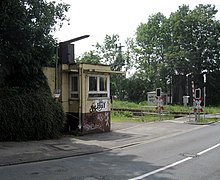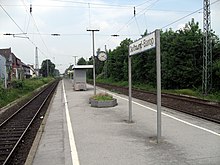Dortmund-Barop train station
| Dortmund-Barop | |
|---|---|
|
Dortmund-Barop stop
|
|
| Data | |
| Operating point type | Breakpoint |
| Location in the network | Intermediate station |
| Platform tracks | 2 |
| abbreviation | EDBA |
| IBNR | 8001527 |
| Price range | 5 |
| opening | December 1848 |
| location | |
| City / municipality | Dortmund |
| Place / district | Barop |
| country | North Rhine-Westphalia |
| Country | Germany |
| Coordinates | 51 ° 28 '39 " N , 7 ° 25' 53" E |
| Railway lines | |
|
|
| Railway stations in North Rhine-Westphalia | |
The former Dortmund-Barop train station is located on the Baroper Marktplatz in the Hombruch district . Since mid-2006 it has only been operationally a stopping point . The operating points abbreviation is EDBA (former Bundesbahndirektion E SEN, Station D ortmund- Ba rop).
history
The Barop station was established in December 1848 as part of the main line of the Bergisch-Märkische Railway . For many years the history has been closely linked to the industrial history in the Barop / Hombruch area. So the station was built primarily for the removal of the conveyed in Barop coal and therefore was in the immediate vicinity of the mine Louise near the Hörder Chaussee (today Stockumer Street ), and the neighboring colliery widow & Barop and the shaft Giesbert the mine Glückauf were close at the station and were given sidings . The Henriette colliery, which is about two kilometers away , was presumably already connected by means of a horse-drawn tugboat when the station opened .
On March 9, 1849, passenger traffic on the route began. Nevertheless, freight traffic remained the determining element: The train station was not only used by the local mines, but also by other companies in the neighborhood to receive and dispatch their goods, especially the Baroper machine works (from 1856) and the Baroper rolling mill from 1862 to call. In 1861 the station was relocated to its current location near Harkortstrasse. The “Clausthal” shaft of the Vereinigte Louise Tiefbau colliery was connected to the station by a cable car in 1865 . From around 1870 another railway connected the station with the Gotthelf shaft of the Glückauf Tiefbau colliery . Finally, from 1895, the Kaiser Friedrich colliery in Menglinghausen was added, which was connected to the Baroper train station.
The gradual decline of the mines in the Barop area began in the 1880s. While the siding to the Holthausen colliery in Eichlinghofen was expanded in 1880, the United Wittwe & Barop and Henriette collieries ceased operations until 1888. The great colliery death put an end to coal handling in Barop in 1925 with the closure of the remaining mines; only the coking plant of the Kaiser Friedrich colliery remained in operation until 1930. The Baroper machine factory was also wound up after the First World War. In the next few years, other industrial companies settled on the fallow land, but the majority of the goods volume was now for the tube rolling mill, which was taken over by Hoesch AG in 1928 . A steel pedestrian bridge was built next to the Harkortstrasse level crossing to cross the tracks. The staircase to the approximately three meter wide bridge was to the left of the "Baf" signal box. The half-timbered arch bridge had a wooden-covered catwalk.
Long after the incorporation of Barops into Dortmund, this fact was also taken into account when the station was renamed "Dortmund-Barop" in May 1950. Also after the Second World War, a switch factory of the Mieves company was opened on the site of the former Wittwe colliery, which was now a brickworks . On 29 July 1967, the three previous were mechanical interlocking "Ba" (formerly "Bat"), "Nt" taken (on Stockumer Straße) and "St" (at the southern end of the station) out of service and the track layout interlocking "Baf “At the level crossing in Harkortstrasse, the building of which had previously served as a barrier post.
In the 1980s, goods traffic began to decline again in Barop: After the goods shed was no longer used for general cargo traffic, it served the "fruit exchange" as a sales outlet for a few years. The pipe factory was closed soon afterwards, as was the Uhde warehouse . The station building from 1861 and the pedestrian bridge were also demolished.
Since May 29, 1994, Barop has been a station on the S 5 line of the Rhine-Ruhr S-Bahn , which began operations between Dortmund and Hagen on that day. Until 2002, the switch factory in Barop was still used for freight traffic, since then the station has only been used for S-Bahn traffic. Due to this decrease in traffic, the remaining points were taken out of service by May 2006 and the entry and exit signals were replaced by block signals , thus converting the station into a stop. The areas freed by the dismantling of the side tracks are for sale.
Traffic importance
| line | course | Tact |
|---|---|---|
| S 5 |
Dortmund Hbf 1 - Status: timetable change December 2019 |
30 min (1–2) 60 min (2–3) |
The stop is not far from downtown Hombruch and on the edge of a larger settlement area in the Baroper area. It is connected to the railway transport network by the S 5 S-Bahn from Dortmund to Hagen (sometimes further than S 8 to Mönchengladbach). The 446 bus also stops near the train station . However, the two neighboring urban transport hubs Barop Parkhaus and Hombruch Gablonzstraße are much better connected to Dortmund's city traffic, which is why the Barop S-Bahn stop is of relatively little importance in the city center.
future
For the reasons listed above, there were plans to relocate the stop a few hundred meters further in the direction of Dortmund city center, where a link with several city bus lines and the U42 tram at the Barop Parkhaus stop will be possible. For cost reasons, Deutsche Bahn AG decided against relocation in 2007. However, this project is part of the current local transport plan for the city of Dortmund.
It is also being considered to extend the H-Bahn , which currently only runs in the area of the university and to Eichlinghofen , to this stop, so that a large traffic junction would be created in the south-west of Dortmund. However, the extension of the H-Bahn is rejected in the standardized assessment as not being economically sufficient and is therefore currently rather unlikely.
Another plan is based on the assumption that the stop will be completely shut down and replaced by two others: On the one hand, the S 5 is to be better linked with the Dortmund light rail and buses by a new stop Dortmund-Barop , on the other hand, a new stop Dortmund- Hombruch are being built to improve the development function of the S5 in the Hombruch suburb. However, this should be done as part of the upgrading of the S5, which was rejected by the integrated overall traffic planning of the state of North Rhine-Westphalia. A resubmission is possible from 2015. Relocating the stop to the "Parkhaus-Barop" and connection to the H-Bahn / U-Bahn in the direction of the Technical University would bring logistical advantages for the approx. 35,000 students.
See also
Individual evidence
- ↑ Michael Tiedt: The early mining on the Ruhr - Zeche Henriette. Retrieved July 23, 2011 .
- ↑ Michael Tiedt: The early mining on the Ruhr - Zeche Glückauf. Retrieved July 13, 2011 .
- ↑ Land acquisition plan for the expansion of the connecting line to the Holthausen colliery at Barop station. Oberbergamt Dortmund, 1880
- ↑ Pro-Bahn Ruhrschiene 2007 # 3, page 11 ( Memento of the original from September 28, 2007 in the Internet Archive ) Info: The archive link was automatically inserted and not yet checked. Please check the original and archive link according to the instructions and then remove this notice.
- ^ Local transport plan 2013 Dortmund page 135 ( Memento from November 8, 2014 in the Internet Archive )


